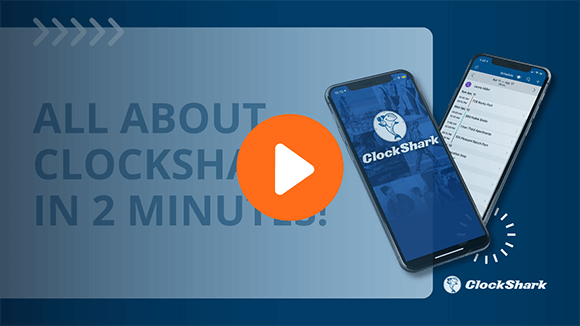Federal Timekeeping Laws for Employees
Employee time card laws can be challenging to navigate, especially for the kind of hours field service employees work, but it’s necessary to understand the ins and outs. This is especially important when it comes to the rules concerning clocking in and out, which directly affect wages and working conditions.
However your field service business operates, these employee time card laws are essential to prevent disruptions, citations, and fines.
Fair Labor Standards Act (FLSA)
The Fair Labor Standards Act (FLSA) outlines federal laws for all employers in the United States. It establishes the private sector minimum wage, overtime pay/requirements, recordkeeping, and youth employment standards at the federal, state, and local levels. It also outlines the minimum and maximum fines for violations of the Act.
Under the FLSA, there are two broad types of employees: exempt and non-exempt.
A non-exempt employee is covered by all laws under the FLSA (with some exceptions for certain professions), while exempt employees aren’t covered.
Broadly, exempt employees meet three requirements: minimum salary above $58,656, are paid a predetermined fixed salary and hold administrative, executive or professional duties. Some exceptions do apply. It’s rare for field service workers to be exempt employees, however, most field service businesses are likely to have office staff who fall into this category. For more details refer to our article on DOL overtime rules
Employers must adhere to federal laws outlined by the FLSA when recording employees' time worked. The FLSA requires employers to keep accurate records of hours worked by non-exempt employees, including the time they start and end their shifts and any meal breaks taken.
If your business contracts for a federal agency, it’s essential to comply with Defence Contract Audit Agency requirements.
Accurate Record-keeping
The FLSA does not specify the method of recording time, but it does require that the method used is accurate and complete to ensure accurate pay and overtime pay. Some employers utilize traditional time clocks or time-tracking systems to track employee hours for each pay period, while others may use digital apps or software.
Businesses are required by law to use a timekeeping method to track employees' time. Timesheets (also known as time cards) are a standard method, as they are widely used and accepted by all kinds of businesses.
Breaks and Meal Periods
Breaks are small periods of time away from work duties, often between 5 and 20 minutes. They are generally compensated and used for things like coffee/snacks or bathroom breaks. The FLSA does not mandate breaks, but they are common for employees to have a quick recharge during work hours.
Meal periods are also not mandated by FLSA employee time card laws, but are widespread to provide employees time to eat. Unlike breaks, meal times are unpaid, however, they come with multiple stipulations to qualify as a meal period.
These are:
- Duration: a meal period must be at least 30 minutes long
- Uninterrupted: the period of 30 minutes or more must be taken as one unbroken period, uninterrupted by work duties of any kind, including answering questions, work calls, texts or emails and performing work tasks.
- State Laws: some states have their own requirements. Employers must abide by the stricter laws (state or federal). Some states mandate meal periods.
Overtime requirements
FLSA regulations for overtime do not cover all employees, and exempt and non-exempt employees define these. Employee time card laws differ depending on the type of employee.
Exempt employees are not entitled to overtime pay.
Non-exempt employees must be paid overtime of 1.5 times their regular rate for any hours worked over the 40-hour maximum per week or 8 hours per day.
As with all parts of the FLSA, exemptions depend on the type of duties, industry, and salary.
State Timekeeping Laws
FLSA is a federal outline enforced nationwide; many states have additional employee time card laws and regulations regarding timekeeping. These state-specific laws can vary in areas such as required meal and rest breaks, overtime pay thresholds, and recordkeeping requirements.
For example, some states may have stricter break requirements than federal law or higher minimum wage rates. Employers must be aware of and comply with federal and state laws to meet all necessary obligations.
Timekeeping Rules for Employees vs Contractors
Another factor in following the correct regulations for your business is the differences in rules between employees and contractors.
The way time tracking works for contractors and employees can differ significantly due to their distinct employment classifications.
Here's a quick breakdown:
Employees:
Mandatory: The Fair Labor Standards Act (FLSA) mandates tracking hours worked for non-exempt employees to ensure minimum wage and overtime pay.
Accuracy: Records must be accurate and maintained for at least three years.
Access: Employees can access and review their own time records.
Flexibility: Some states may allow alternative methods, like activity reports, for certain professions.
Contractors:
No federal mandate: No nationwide law requires time tracking for contractors.
Contractual agreement: Tracking might be required based on individual contracts, especially for hourly agreements or project milestones.
Focus on deliverables: Tracking often documents specific tasks and deliverables for billing purposes.
Government contracts: Contractors must record all employee hours worked on government contracts, including overtime, vacation, and sick leave. Based on DCAA timekeeping requirements, this information must be accurate and recorded promptly, usually daily or weekly.
![]()
Employee Time Card Laws for Different Work Scenarios
Field service businesses need to handle time effectively. How do employee time card laws affect different issues and work processes?
Your field service business can approach compliance in various ways, but it is essential to stay consistent and maintain robust documentation. Encourage workers to track their time accurately, including start and end times, breaks, and overtime periods, and remind the team that honest timekeeping is fair for everyone.
However, what are some of the employee time card laws, and how do they affect real-life scenarios? Your business has reasonable options for handling timekeeping challenges while remaining compliant with relevant laws.
Handling Missed Punches and Late Clock-Ins
Missed punches, late clock-ins or inaccurate timesheet inputs are stressful for everyone. Your employees may fear missing out on pay for hours worked, and your business needs to be sure they were present for the work you’re paying them for. Denying employees pay can have serious legal ramifications, even if you have good reason to believe they didn’t do the work.
Simple mistakes or access issues that prevent workers from properly clocking in for work can cause cases of missed punches or clock-ins. To protect your business from legal challenges, establish a clear attendance policy, enforce it consistently, and keep your attendance records.
Grace Periods in your attendance policy
- Define acceptable grace periods: Allow a small buffer (e.g., 5–10 minutes) for late arrivals or early departures without penalty. This accounts for minor delays or unforeseen circumstances.
- Consequences for exceeding grace periods: Clearly outline the consequences for exceeding the grace period. This could involve docked pay, verbal warnings, or progressive discipline, depending on the severity and frequency of the offense.
- Reporting requirements: Specify how employees should report late arrivals or early departures. This could involve notifying a supervisor, using a specific form, or explaining the reason in the timesheet system.
- Justification for exceptions: Outline situations where late arrivals or early departures may be justified, such as doctor's appointments, family emergencies, or pre-approved leave. These exceptions should require prior notification and documentation.
Defining and outlining your expectations is important and can protect your business should any legal issues arise.
Tracking Time for Remote and Field Workers
As mentioned above, accurately tracking time is an essential obligation of businesses to remain compliant. Your business is required to track the time of your remote/field service workers consistently and accurately.
Time-tracking tools have evolved beyond manual punch clocks, job cards and timesheets, presenting flexible options for time-tracking to ensure accurate pay.
The widespread use of GPS-tracking capable devices means your time tracking can be based on location and even set automatically to reduce micromanaging while ensuring accuracy. Your business is legally permitted to track employee location for time tracking during scheduled work hours.
Reliable mobile time-tracking apps with remote clock-in/clock-out features are an excellent option for accurate time tracking for field service employees, and apps with GPS-based tracking will ensure transparent data about work hours. Preventing time theft and buddy punching requires a multifaceted approach that balances security with trust and practicality.
Timekeeping for Non-Exempt vs. Exempt Employees
Under the FLSA, a timekeeping method is required for non-exempt employees. In contrast, the FLSA doesn't cover exempt employees and employee time card laws and regulations vary. Your business is not legally required to track time for exempt employees; however, there are good reasons to.
Consistent timekeeping methods, documentation, and accountability all contribute to a healthier workplace, both from a budget and morale perspective.
Accurate Time-Tracking Methods
As timekeeping methods are required by law under the FLSA, what tools can your business utilize to remain compliant with employee time card laws? You need an accessible system that employees can easily use to clock in and out regularly.
This goes beyond timesheets and ensures your business can accurately track time while distinguishing between overtime, breaks, and PTO.
- Traditional punch clocks: These classic time clocks use paper cards that employees punch to record their start and end times. While they are simple and relatively inexpensive, they can be prone to errors and buddy punching.
- Time-tracking apps: These apps allow employees to clock in and out using their smartphones or tablets. This can be a convenient option for workers who are on the go.
- Biometric time clock: These clocks use fingerprint or facial recognition technology to identify employees. They can be more expensive than other types of time clocks and may raise privacy concerns for some workers.
- PIN entry time clock: These time clocks require employees to enter a personal identification number (PIN) to clock in and out. They are simple to use but can be inaccurate if employees forget or share their PINs.
- Proximity card time clock: These clocks track employee time using proximity cards (similar to key cards). Employees simply hold their cards up to the reader to clock in and out.
- Swipe cards: These time clocks record employees' time using magnetic-stripe cards. Employees swipe their cards through the reader to clock in and out. Magnetic-stripe card time clocks are less expensive than proximity card time clocks but less secure.
Stay Compliant with Timekeeping and Time Card Laws
Keeping compliant with relevant laws and time clock rules does not have to be an obstacle for your business: in fact, using best practices to follow laws and regulations can be a net positive to your field service operation. A culture of accountability, employee trust and fairness will increase morale, improve skilled worker retention, and provide a better workplace.
In addition, implementing software like ClockShark can improve the transparency of your timesheets and give your business valuable insights that can better scheduling, dispatch and customer service, as well as provide an easy way to track employee time in the field.
Try ClockShark free for 14 days to see what a difference it can make for your time tracking and scheduling needs.
Disclaimer: The information provided in this blog is for general informational purposes only and is not intended to serve as legal, financial, or professional advice. Labor laws, including timesheet and wage regulations, vary by jurisdiction and may change over time. You should consult with a qualified legal or labor professional to ensure compliance with applicable laws specific to your circumstances. ClockShark is a software provider and does not provide legal services or guarantees regarding the accuracy or applicability of the information in this blog. Use of our software does not ensure compliance with labor laws or regulations.





